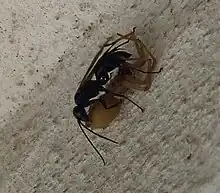Ageniellini
Ageniellini, known as the mud-nesting spider wasps, is a tribe of spider wasps in the subfamily Pepsinae.
| Ageniellini | |
|---|---|
 | |
| Auplopus carbonarius, with prey. | |
| Scientific classification | |
| Domain: | Eukaryota |
| Kingdom: | Animalia |
| Phylum: | Arthropoda |
| Class: | Insecta |
| Order: | Hymenoptera |
| Family: | Pompilidae |
| Subfamily: | Pepsinae |
| Tribe: | Ageniellini |
| Genera | |
|
16 genera (see text) | |
Description
The Ageniellini are slender-bodied spider wasps. They are distinguished from most other Pompilidae by their petiolate abdominal structure and typical absence of a transverse carina on the first segment of the gaster. These traits are, however, shared with Melanagenia of the tribe Pepsini, which is separated by the lack of malar space, deep lateral sulcus of the pronotum, and wing venation.[1][2]
Distribution
The tribe Ageniellini is cosmopolitan.[3]
Behavior
Members of Ageniellini have one of three lifestyles that either invade the nests of other spider wasp nests as kleptoparasites, build their own nests in dry soil, or build thimble-shaped nests out of mud.[3] The most common of these nesting strategies is building mud nests, which are frequently communal in contrast to most other spider wasp groups.[4] As typical of the rest of the family, the Ageniellini provision their nests with a single spider and then lay an egg on it.[1] Most of the species remove the legs of their spider prey before bringing it to the nest.[4][5]
Genera
There are 16 genera within Ageniellini.[3]
- Ageniella Banks, 1912
- Atopagenia Wasbauer, 1987
- Auplopus Spinola, 1841
- Cyemagenia Arnold, 1946
- Dichragenia Haupt, 1950
- Eragenia Banks, 1946
- Dimorphagenia Evans, 1973
- Machaerothrix Haupt, 1938
- Macromerella Banks, 1934
- Macromeris Lepeletier, 1831
- Paragenia Bingham, 1896
- Phanagenia Banks, 1933
- Mystacagenia Evans, 1973
- Phanochilus Banks, 1944
- Poecilagenia Haupt, 1926
- Priocnemella Banks, 1925
References
- Waichert, Cecilia; Rodriguez, Juanita; Wasbauer, Marius S.; von Dohlen, Carol D.; Pitts, James P. (2015). "Molecular phylogeny and systematics of spider wasps (Hymenoptera: Pompilidae): redefining subfamily boundaries and the origin of the family". Zoological Journal of the Linnean Society. 175 (2): 271–287. doi:10.1111/zoj.12272. S2CID 55521404.
- Wahis, Raymond; Durand, Frédéric; Villemant, Claire (2009). "Pompiles de l'île d'Espiritu Santo, Vanuatu (Insecta, Hymenoptera, Pompilidae)". Zoosystema. 31 (3): 707–718. doi:10.5252/z2009n3a15. S2CID 86110455.
- Shimizu, Akira; Wasbauer, Marius; Takami, Yasuoki (2010). "Phylogeny and the evolution of nesting behaviour in the tribe Ageniellini (Insecta: Hymenoptera: Pompilidae)". Zoological Journal of the Linnean Society. 160 (1): 88–117. doi:10.1111/j.1096-3642.2009.00592.x.
- Gess, Sarah K.; Gess, Friedrich W. (2014). Wasps and bees in southern Africa. Grahamstown: Pretoria: South African National Biodiversity Institute. ISBN 978-1-919976-73-0.
- Carvalho-Filhoa, Fernando da Silva; Aukob, Tiago Henrique; Waichert, Cecília (2015). "Observations on the nesting behaviour of the spider wasp Eragenia congrua (Hymenoptera: Pompilidae), with the first record of the host". Journal of Natural History. 49 (33–34): 2035–2044. doi:10.1080/00222933.2015.1006701. S2CID 85426104.